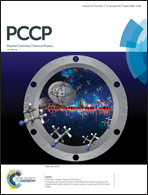Chirped-pulse Fourier transform millimeter-wave spectroscopy of ten vibrationally excited states of i-propyl cyanide: exploring the far-infrared region†
Abstract
We report here further spectroscopic investigation of the astrochemically relevant molecule i-propyl cyanide. We observed and analysed the rotational spectra of the ground state of the molecule and ten vibrationally excited states with energies between 180–500 cm−1. For this, we used a segmented W-band spectrometer (75–110 GHz) and performed the experiments under room temperature conditions. This approach thus provides access to high-resolution, pure rotational data of vibrational modes that occur in the far-infrared fingerprint region, and that can be difficult to access with other techniques. The obtained, extensive data set will support further astronomical searches and identifications, such as in warmer regions of the interstellar space where contributions from vibrationally excited states become increasingly relevant.



 Please wait while we load your content...
Please wait while we load your content...